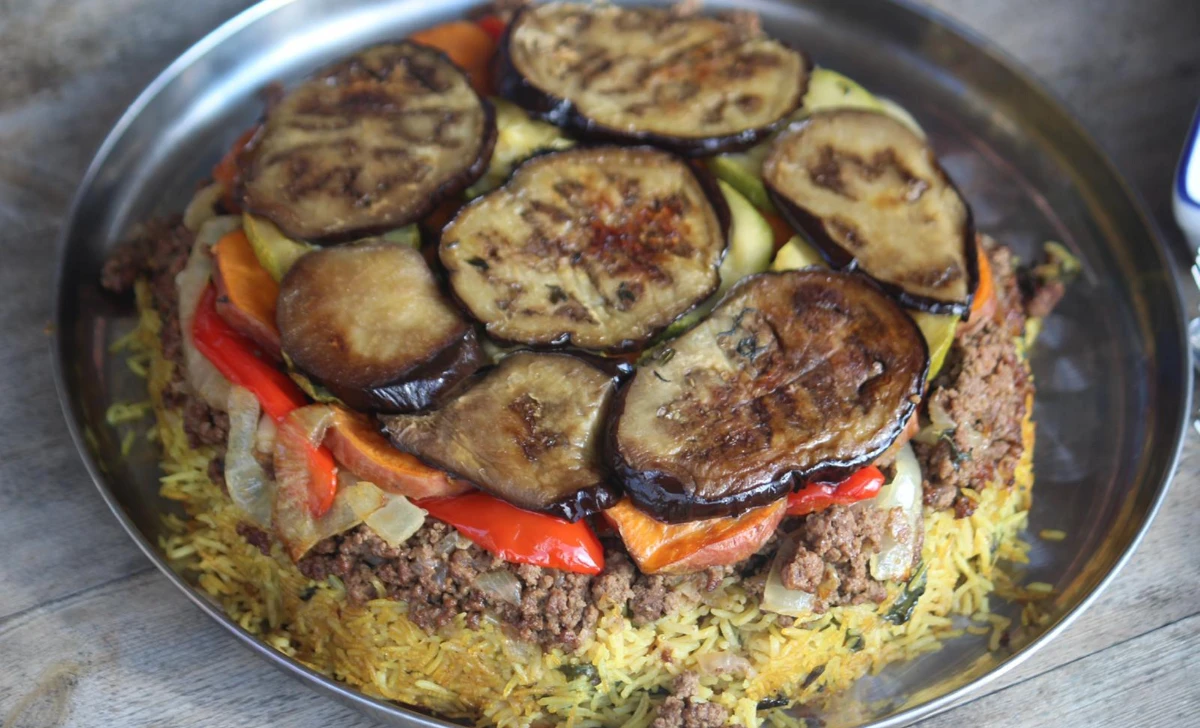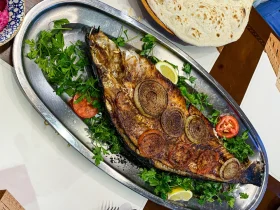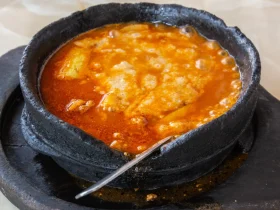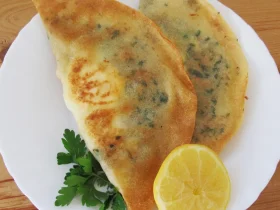In the rich tapestry of Middle Eastern cuisine, few dishes can rival the exquisite taste and cultural significance of Maqluba. Translated as “upside-down” in Arabic, Maqluba is a delectable one-pot dish that combines fragrant rice, tender meat, and an assortment of vegetables. This article will take you on a flavorful journey, exploring the history, ingredients, and step-by-step process of preparing this beloved dish. So, fasten your seatbelt, and let’s delve into the enchanting world of Maqluba.
[ez-toc]
History
Maqluba, a cherished Middle Eastern dish, boasts a rich history that dates back centuries. Originating in the Levantine region, which includes modern-day countries like Jordan, Palestine, and Lebanon, Maqluba has become an emblematic culinary delight in this part of the world.
The name “Maqluba” itself speaks to the essence of the dish. In Arabic, “Maqluba” translates to “upside-down,” which is a reference to the unique presentation of the meal. Traditionally, Maqluba is prepared by layering rice, meat, and vegetables in a pot, which is then cooked until the flavors meld together. Once ready, the pot is carefully flipped upside-down onto a serving platter, revealing a stunning arrangement of colors and textures.
The history of Maqluba is closely intertwined with the region’s rich cultural heritage. It has long been a symbol of hospitality and generosity, often prepared to welcome guests and celebrate special occasions. Families would gather around the table, savoring the dish’s delightful blend of aromas and tastes, fostering a sense of togetherness and community.
While the exact origins of Maqluba remain shrouded in the mists of time, its enduring popularity is a testament to its timeless appeal. Today, this savory masterpiece continues to be passed down through generations, preserving not just the flavors but also the memories and traditions of Middle Eastern culture. So, let’s explore the key ingredients that make Maqluba an absolute culinary delight.
Time
| Step | Time Required |
|---|---|
| Preparation and Marination | 20 minutes |
| Sautéing Meat | 15 minutes |
| Preparing Vegetables | 10 minutes |
| Layering the Ingredients | 10 minutes |
| Cooking the Maqluba | 40 minutes |
| Resting Time | 10 minutes |
| Total Time | 1 hour 45 minutes |
Note: The preparation and cooking times are approximate and may vary based on individual cooking skills and equipment used. Enjoy the cooking process and the delightful aroma that fills your kitchen as you create this exquisite Middle Eastern dish.
Ingredients
| Quantity | Ingredients |
|---|---|
| 1 cup | Basmati rice |
| 250g | Chicken or lamb (bone-in, cut into pieces) |
| 1 | Large eggplant (sliced) |
| 1 | Large potato (sliced) |
| 1 | Large onion (sliced) |
| 2 | Ripe tomatoes (sliced) |
| 2 | Garlic cloves (minced) |
| 1/4 cup | Olive oil |
| 1/2 teaspoon | Ground cumin |
| 1/2 teaspoon | Ground coriander |
| 1/4 teaspoon | Ground cinnamon |
| 1/4 teaspoon | Ground allspice |
| 1/4 teaspoon | Ground turmeric |
| 1/4 teaspoon | Ground black pepper |
| 1/4 teaspoon | Ground cardamom |
| 1/4 teaspoon | Ground nutmeg |
| 1/4 teaspoon | Red pepper flakes (optional, for some heat) |
| 2 cups | Chicken or vegetable broth |
| Salt and pepper | To taste |
| 1/4 cup | Chopped fresh parsley or cilantro |
| 1/4 cup | Fried nuts (almonds, pine nuts, or cashews) |
Note: Adjust the quantity of ingredients according to personal preferences and dietary requirements. Enjoy the delightful flavors of Maqluba in this 2-person serving size!
Directions
Step 1: Preparation and Marination
- Marinate the Meat: Begin by marinating the chicken or lamb pieces with a mixture of olive oil, minced garlic, ground cumin, ground coriander, ground cinnamon, ground allspice, ground turmeric, ground black pepper, ground cardamom, ground nutmeg, and red pepper flakes (if desired). Allow the meat to marinate for at least 20 minutes to infuse it with flavorful spices.
Step 2: Sautéing Meat
- Sauté the Meat: In a large, deep pot or Dutch oven, heat some olive oil over medium heat. Add the marinated meat and sear it until it turns golden brown on all sides. This will lock in the juices and enhance the taste of the Maqluba.
Step 3: Preparing Vegetables
- Prep the Vegetables: While the meat is browning, prepare the vegetables. Slice the eggplant, potato, onion, and ripe tomatoes into uniform thin slices. These vegetables will add layers of delightful flavors to the Maqluba.
Step 4: Layering the Ingredients
- Layer the Pot: Now, it’s time to create the signature Maqluba layers. Begin by arranging the sliced potatoes at the bottom of the pot to form the first layer. Next, add a layer of eggplant slices on top of the potatoes, followed by a layer of onions. Then, add the seared meat as the next layer, and finally, place the sliced tomatoes on top. Each layer contributes to the overall taste and presentation of the dish.
Step 5: Cooking the Maqluba
- Add Broth and Rice: Pour the chicken or vegetable broth over the layered ingredients in the pot. Then, add the basmati rice evenly over the top. Make sure the rice is thoroughly rinsed before adding it to the pot to prevent excess starch.
- Season and Bring to a Boil: Season the rice with salt and pepper to taste. Bring the pot to a boil over medium heat, then reduce the heat to low, cover the pot with a tight-fitting lid, and let it simmer gently for approximately 30 to 35 minutes. The rice will absorb the flavorful broth, and the ingredients will meld together, creating a delightful harmony of tastes.
Step 6: Resting Time
- Let It Rest: After cooking, turn off the heat and let the Maqluba rest for about 10 minutes. This resting period allows the flavors to further develop, and the dish to set, making it easier to serve.
Step 7: Serving the Maqluba
- Invert and Serve: Carefully invert the pot onto a large serving platter, revealing the beautifully layered Maqluba. The rice and vegetables should now be on top, showcasing the delightful “upside-down” presentation.
- Garnish and Enjoy: Sprinkle chopped fresh parsley or cilantro and fried nuts (almonds, pine nuts, or cashews) over the Maqluba to add a burst of color and texture. Serve the dish hot and savor the authentic taste of this Middle Eastern delight.
Equipment Required
Nutrition Information
| Nutrient | Amount Per Serving |
|---|---|
| Serving Size | 1 plate |
| Calories | 600 kcal |
| Total Fat | 28g |
| – Saturated Fat | 6g |
| – Trans Fat | 0g |
| Cholesterol | 75mg |
| Sodium | 700mg |
| Total Carbohydrates | 65g |
| – Dietary Fiber | 6g |
| – Sugars | 5g |
| Protein | 26g |
| Vitamin D | 0.8mcg |
| Calcium | 80mg |
| Iron | 4.5mg |
| Potassium | 680mg |
Note: The nutrition information is approximate and may vary based on the specific ingredients and quantities used in the recipe. Nutritional values were calculated using standard food databases and are intended for general informational purposes. For precise nutritional information, consider using specialized nutritional software or consulting a registered dietitian. Enjoy Maqluba as part of a balanced diet, rich in a variety of nutrients.
Tips
- Choose the Right Pot: Opt for a deep pot or a Dutch oven with a tight-fitting lid to ensure even cooking and to prevent the steam from escaping during the simmering process.
- Marinate for Enhanced Flavor: Allow the meat to marinate for a longer time, even overnight, to infuse it with the aromatic spices, resulting in a more flavorful and tender outcome.
- Adjust Spice Levels: Tailor the spice blend to your taste preferences. If you prefer a spicier Maqluba, increase the amount of red pepper flakes, and if you enjoy milder flavors, reduce or omit them.
- Perfect Rice Texture: Rinse the basmati rice under cold water until the water runs clear. This removes excess starch and helps achieve light, fluffy rice grains.
- Layer Uniformly: Try to cut the vegetables into similar thickness to ensure even cooking and consistent layers in the final presentation.
- Be Patient While Simmering: Allow the Maqluba to simmer gently on low heat. Avoid stirring the pot to maintain the beautiful layered presentation.
- Test for Doneness: To check if the Maqluba is cooked, insert a fork into the rice. It should be tender, not mushy.
- Rest Before Serving: Letting the Maqluba rest after cooking allows the flavors to meld, enhancing the overall taste and texture.
- Garnish Creatively: Elevate the dish’s appearance and taste by experimenting with different garnishes, such as toasted nuts, pomegranate seeds, or fried onions.
Pros & Cons
| Pros | Cons |
|---|---|
| ✅ Bursting with Flavor | ❌ Time-Consuming to Prepare |
| ✅ Unique “Upside-Down” Presentation | ❌ Requires Multiple Cooking Steps |
| ✅ Rich in Nutritious Ingredients | ❌ May Require Special Spices |
| ✅ Perfect Dish for Special Occasions | ❌ Not Suitable for Quick Meals |
| ✅ Showcases Middle Eastern Culture | ❌ Requires Careful Layering |
Conclusion
Embark on a culinary journey to the enchanting Middle East with Maqluba, a dish that embodies the heart and soul of this rich and vibrant region. With its layers of fragrant rice, tender meat, and colorful vegetables, Maqluba is not just a meal; it’s a celebration of culture and tradition. The unique “upside-down” presentation adds a touch of magic to the dining experience, making it a feast for the senses.
While preparing Maqluba may require some time and effort, the end result is well worth it. Each bite is a burst of enticing flavors, inviting you to savor every moment and relish the authentic taste of Middle Eastern cuisine.
Whether you’re hosting a special occasion or simply seeking to delight your taste buds with something extraordinary, Maqluba is the perfect choice. Impress your guests with this visually stunning dish or treat your family to a heartwarming homemade meal that will leave them asking for more.
So, roll up your sleeves, gather the ingredients, and dive into the joy of creating Maqluba. Let the enticing aroma fill your kitchen as you layer the ingredients with love and care. Embrace the art of cooking and embrace the cultural heritage encapsulated in this beloved Middle Eastern delight.
Don’t miss the chance to experience the magic of Maqluba. Gather your loved ones, share in the joy of preparing and enjoying this flavorful masterpiece, and create lasting memories together. Bon appétit!
Facts
- Fact 1: Upside-Down Origin 🧩
- 🍽️ The name “Maqluba” comes from the Arabic word “maqlab,” meaning “upside-down.” The dish is prepared by layering the ingredients in a pot, cooking them together, and then flipping it upside-down onto a serving platter, revealing a beautiful, layered masterpiece!
- Fact 2: A Dish of Generosity 🎁
- 🍗 Maqluba holds significant cultural importance, often prepared to celebrate special occasions like weddings and family gatherings. It symbolizes hospitality and generosity, welcoming guests with a bountiful feast and spreading joy through food and camaraderie.
- Fact 3: A Royal Connection 👑
- 🏰 Legend has it that Maqluba was created by a chef in medieval times to impress a visiting king. Wanting to present something extraordinary, the chef carefully layered the ingredients, creating the awe-inspiring “upside-down” dish that won the king’s heart!
- Fact 4: A Tale of Sharing 🌐
- 🌍 Maqluba’s popularity extends far beyond its Middle Eastern roots. With variations found in different countries like Greece, Turkey, and India, each region adds its unique twist to this beloved one-pot wonder, uniting cultures through the love of food.
- Fact 5: Maqluba in Pop Culture 🎬
- 📺 Maqluba has even made appearances in pop culture! It has been featured in popular cooking shows and movies, showcasing its intriguing preparation process and delectable flavors, making it a star both on-screen and in our kitchens!
FAQ’s
Can I use a different type of rice for Maqluba?
While Basmati rice is traditional, you can experiment with other long-grain rice varieties. However, keep in mind that the texture and flavor may differ slightly.
Can I make Maqluba ahead of time?
Yes, you can prepare the layered ingredients in advance and cook the Maqluba just before serving for the best results.
Is Maqluba suitable for vegetarians?
Absolutely! You can make a delicious vegetarian version using chickpeas, tofu, or an assortment of colorful vegetables.
How do I prevent the rice from sticking to the pot?
Rinsing the rice thoroughly before cooking helps remove excess starch, preventing it from sticking. Additionally, using a non-stick pot or adding a little extra oil can also help.
Can I substitute the meat with seafood?
Yes, you can try a seafood twist by using firm fish fillets like cod or salmon. Adjust the cooking time accordingly to ensure the fish is cooked through.
Can I freeze leftover Maqluba?
While Maqluba can be frozen, the texture of the rice and vegetables may change slightly upon reheating. For the best taste, consume it fresh.
How can I make Maqluba more colorful?
You can add vibrant hues to Maqluba by including colorful bell peppers, carrots, or even saffron-infused rice layers.
What side dishes pair well with Maqluba?
Maqluba pairs wonderfully with refreshing salads, yogurt-based dips like tzatziki, and pickled vegetables to balance the flavors.
Can I use pre-cooked meat for Maqluba?
While using pre-cooked meat may save time, it’s best to cook the meat along with the spices to enhance the overall taste and aroma of the dish.
Is Maqluba a spicy dish?
The spiciness of Maqluba can be adjusted to suit your taste preferences. The amount of red pepper flakes and other spices can be increased or decreased as desired.












Leave a Review